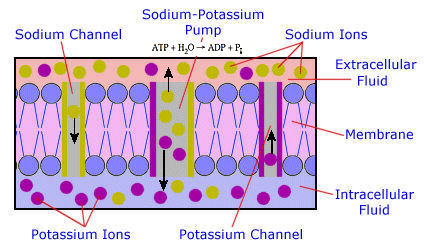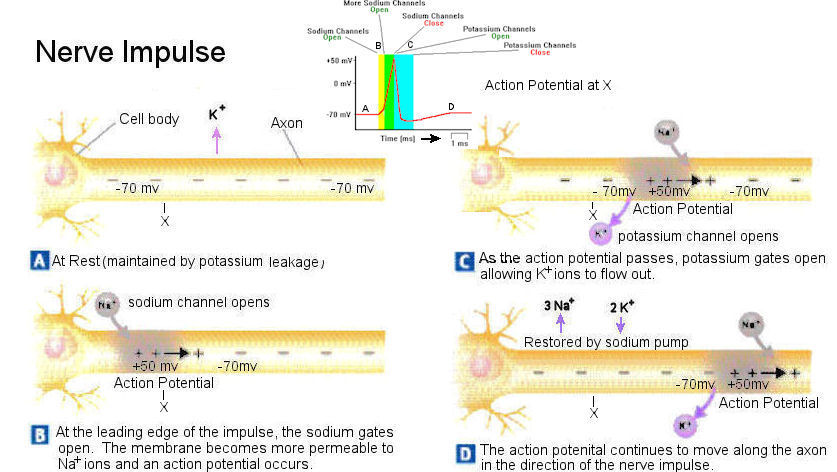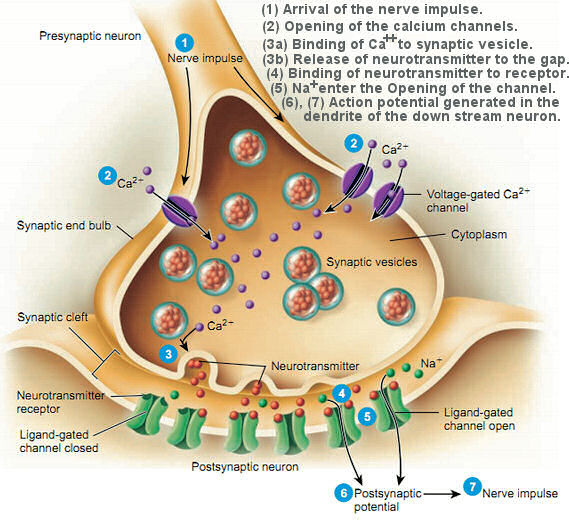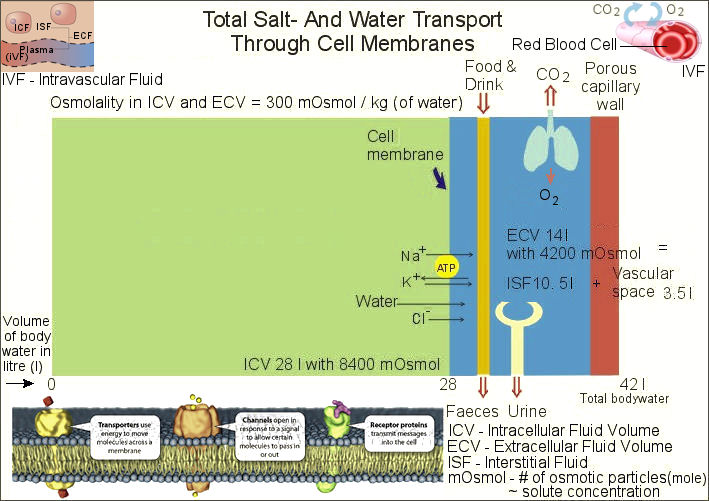 |
|
Figure 05 Origin of Life |
 |
arrange so that the hydrophobic "tail" regions are isolated from the surrounding polar fluid, causing the more hydrophilic "head" regions to associate with the intracellular and extracellular fluid (Figure 06). Such arrangement is essential because most of the life supporting materials (and waste) are solvable in water. The pores (with a size of ~ 10-6 cm) occupy about 50% of the surface, and are inserted on the membrane in order to facilitate the absorption (of nutrient) and removal (of waste). Since the membrane has the consistency of machine oil, the pores tend to float about and must be anchored by cytoskeletion. |
Figure 06 Cell Membrane |
Pores that process passive transport letting substance in and out through concentration gradient are called channels, while those use energy in active transport to move the substance against its concentration gradient are called pump. This is one of the indicators to show the non-equilibrium nature of life (see also "carbon compounds"). |
 |
 |
The production of ATP is another example of bio-electricity at work. It relies on the proton (H+) pump to establish a concentration gradient (or electrical potential). This pump obtains its energy by the redox gradient which extracts energy from the electron as it move down the redox energy scale. A positive electric potential is built up as the proton (H+P) concentration increases in the intermembrane space. Consequently protons move down the gradient through a pore called ATP synthase, which converts ADP to ATP by adding one more phosphate into the structure (see |
Figure 07 ATP Synthase |
Figure 08 |
Figure 07, also see an animation on the synthesis of the ATP from individual ADP and Pi to an intermediate stage of ADP-P in the F1 domain - a view from the top). Energy is infused into ATP in the process. This is a |
The ATPs sustain most of the energy requirement within the cells in most organisms on Earth. It is used for synthetic reactions, active transport, nervous conduction, and muscle contraction. A speific example is the operation of the sodium pump, which would not work without the presence of ATP (see Figure 06).
The chain of respiration process starts with glucose and oxygen entering the mitochondria (Figure 08). Two sub-pathways in the intermediate stage separate the glucose C6H12O6 into CO2 and H. The hydrogen is broken down further into H+ and e-. The electron goes through a transport chain to pump out the H+, which in turn re-enter via the ATP synthase to generate the ATP (with ~ 0.32 ev/ATP stored in the extra phosphate link). Eventually, the H+ and e- combines with O2 to produce water to complete the process, which can be summarized in chemical formula as : C6H12O6 + 6O2
 6CO2 + 6H2O + energy.
6CO2 + 6H2O + energy.See more about ATP in "ATP - Energy Supplier for Life (2020 Edition)".
Three Germ Layers").
 |
|
Figure 11 Conformal Change of Retinal |
See the "Five Senses". |
 |
 |
|
Figure 12 Neuron |
Figure 13 Nerve Impulse |
(B) - A triggering action opens the sodium channel. The inflow of Na+ ions raises the voltage to +50 mv - the peak of the "action potential".
(C) - The potassium channel opens to let the K+ ions out dropping the voltage back to -70 mv.
(D) - The change in voltage induces the next sodium channel to open repeating the sequence so that the electrical impulse
 |
moves along down stream to the synapse (the terminal), where the release of neurotransmitters passes the impulse to the dendrite of another neuron cell. The sodium pump re-establish the resting condition up stream by moving K+ ions in and Na+ ions out. The sequence of synaptic action after the arrival of nerve impulse starts with the opening of ion channels, which allow calcium ions to rush in (see Figure 14). This is one more example of bio-electricity in action. Since proper calcium ion concentration is vital for a host of functions within the cell (such as : triggering a fertilized egg to develop, skeletal muscle cells to contract, secretion by secretory cells, ... etc.), there are calcium pumps to maintain low concentration of free Ca2+ in the cytosol. |
Figure 14 Synapse [view large image] |
See more in "Neurotransmitters". |
- Notes :
- Neurotransmitter comes in many types (see Types of Neurotransmitter). However, it is not the only chemical messenger employed by organisms to communicate. There are hormones transmit long-range signals to initiate action in other cells; pheromones to act (by diffusion in the air) as sexual attractants, territorial markers and alarm bells.
- Electrical synapse transmits nerve impulse by direct contact. It is about ten times faster and is used for quick response.



